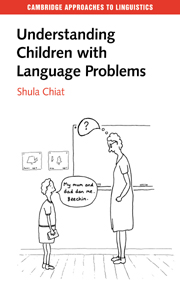Book contents
- Frontmatter
- Contents
- Acknowledgements
- Glossary of text conventions and symbols
- Introduction
- Part I Problems with words
- Part II Grappling with verb structure
- 7 Translating events
- 8 Growing verb structures
- 9 Shortfalls with verbs
- 10 ‘Thing out. Tip in there’: problems with verb processing
- Part III Missing function morphemes
- Part IV Hidden meanings, baffling meanings
- Endpoint and springboard
- Further reading
- References
- Index
9 - Shortfalls with verbs
Published online by Cambridge University Press: 05 September 2012
- Frontmatter
- Contents
- Acknowledgements
- Glossary of text conventions and symbols
- Introduction
- Part I Problems with words
- Part II Grappling with verb structure
- 7 Translating events
- 8 Growing verb structures
- 9 Shortfalls with verbs
- 10 ‘Thing out. Tip in there’: problems with verb processing
- Part III Missing function morphemes
- Part IV Hidden meanings, baffling meanings
- Endpoint and springboard
- Further reading
- References
- Index
Summary
When children have problems with words, their problems may hit some types of words harder than others. A number of studies of language-impaired children have exposed verbs as an area of particular difficulty.
One study involved an extensive comparison of the words and structures used by a group of language-impaired children and a group of normally developing children (Fletcher & Peters 1984). The two groups were of similar age and non-verbal intelligence. Each child's language was sampled in four different activities: free play with toys, talking about pictures in a book, playing a board game, and re-telling a story about a set of pictures. Each sample consisted of 200 utterances, 50 from each activity. The samples from the two groups of children were then compared in terms of a wide range of lexical and grammatical categories. This revealed that the vocabulary of the language-impaired children was generally more restricted than the vocabulary of the normally developing children, and significantly, the verb range of the languageimpaired children was especially limited.
Similarly, in a study focusing on verb use, it was found that a group of fourteen language-impaired children had a narrower range of verbs than normally developing children matched in age (Watkins, Rice & Moltz 1993). Even more striking, though, was the comparison between these language-impaired children and a group of normally developing children who were nearly two years younger than them, but at the same general language level. The verb range of the language-impaired group was still more limited than that of the control group, even though their vocabularies as a whole did not differ significantly.
- Type
- Chapter
- Information
- Understanding Children with Language Problems , pp. 144 - 162Publisher: Cambridge University PressPrint publication year: 2000

